 |
Picks is a monthly sampling of Japan's art scene, offering commentary by a variety of reviewers about exhibitions at museums and galleries in recent weeks, with an emphasis on contemporary art by young artists. |
 |
 |
|
|
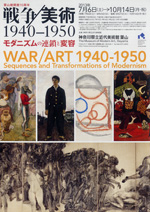 |
 |
 |
 |
| WAR/ART 1940-1950: Sequences and Transformations of Modernism |
| 6 July - 14 October 2013 |
The Museum of Modern Art, Hayama
(Kanagawa) |
 |
| The museum commemorates its tenth anniversary with this thought-provoking show on Japanese art of the 1940s. The comparisons set up between the "war paintings" of the era and those of other genres, particularly post-surrender art, are illuminating. Japanese art history tends to view World War II as an interruption dominated by the invasive genre of war paintings, but this exhibition eschews the typical prewar/postwar division, rightly highlighting the "sequences and transformations" apparent when one treats the era as one continuum. |
|
 |
 |
 |
 |
|
|
Yukihisa Isobe: Environment, Image, Representation
|
| 3 August - 4 November 2013 |
Ichihara Lakeside Museum
(Chiba) |
 |
| The watery ambience of the Ichihara Lakeside Museum, located amid the hills of the central Boso Peninsula, is pleasant enough, but the building itself consists of an uninspired agglomeration of undressed concrete blocks and circular arcs. Besides the current exhibition, featuring the oeuvre of the celebrated avant-gardist-cum-ecological planner Isobe (b. 1935), works by KOSUGE1-16, Ryota Kuwakubo, and Vito Acconci are on display. The overarching theme is ostensibly the environment, a bit too broad a concept to provide much context. The museum will host the "Ichihara Art x Mix" international art festival next spring, but aside from that, can't be said to warrant a second look. |
|
|
|
|

|
 |
 |
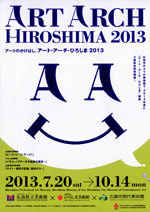 |
|
Art Arch Hiroshima 2013 |
| 20 July - 14 October 2013 |
Hiroshima Prefectural Art Museum
Hiroshima Museum of Art
Hiroshima City Museum of Contemporary Art
(Hiroshima) |
 |
| Loosely linked by the works of sculptor Isamu Noguchi, who was deeply involved with postwar Hiroshima architecture, this joint project by three of the city's major museums offers a trio of disparately themed exhibitions. At the Museum of Contemporary Art's "SITE" show, a particularly compelling piece is Michael Rakowitz's installation The Invisible Enemy Should Not Exist (Recovered, Missing, Stolen Series), which features papier-mache replicas of artifacts missing from the National Museum of Iraq, Baghdad, devastated by looting and arson during the 2003 U.S. invasion. Made of disposable wrapping, packaging, and newspapers from Iraq, the replicas are accompanied by detailed descriptions of the original artifacts. |
|
|
 |
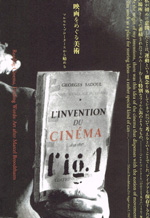 |
|
Reading Cinema, Finding Words: Art after Marcel Broodthaers |
|
7 September - 27 October 2013
|
|
The National Museum of Modern Art, Kyoto
(Kyoto) |
 |
| Belgian-born Broodthaers (1924-76) started out as a poet but became known for films, objects, and installations in which he explored the relationship between words and images. This show introduces works by a dozen younger artists influenced by him, among them Miwa Yanagi, Koki Tanaka, Anri Sala, Cindy Sherman, and Ana Torfs. Films, photographs, videos, and installations are grouped into five sections on varying themes. |
|
|
|
|
|
|
|

|
 |
 |
|
 |
|
 |
|
| Rokko Meets Art 2013 |
|
14 September - 24 November 2013
|
Hyogo Prefecture, various locations
(Hyogo) |
 |
| The pleasures of Mt. Rokko, which looms above the port city of Kobe, can be appreciated anew through this annual event that encourages strolling and picnicking atop the mountain among works of mostly outdoor art. This, the fourth iteration, features 35 artists and art units, including Yoshiaki Kaihatsu, Osamu Kokufu, Ryota Kuwakubo, Minako Nishiyama, and Kyotaro Hakamata, as well as the redoubtable Meiwa Denki and four other performance groups. |
|

|
 |
 |
|
|
|
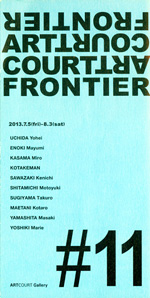 |
|
|
 |
|
|
| Art Court Frontier 2013 #11 |
|
5 July - 3 August 2013
|
Art Court Gallery
(Osaka) |
 |
| Ten of Japan's most prominent artists, curators, collectors, and art journalists were asked to recommend one artist each for this annual show, now in its 11th year. The selectees for 2013 were Yohei Uchida, Mayumi Enoki, Miro Kasama, Kotakeman, Kenichi Sawazaki, Motoyuki Shitamichi, Takuro Sugiyama, Kotaro Maetani, Masaki Yamashita, and Marie Yoshiki. One particular standout was Sawazaki's video installation. |
|
|
|
|
 |
|
|
|
|
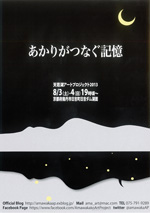 |
 |
|
| Lake Amawaka Art Project 2013 |
| 3 - 4 August 2013 |
Lake Amawaka, Hiyoshi-cho, Nantan-shi
(Kyoto) |
 |
| Completed in 1997 on the Katsura River a few kilometers northwest of Kyoto, the Hiyoshi Dam submerged 122 homes in five villages. This annual event, which covers the lake surface with LED lanterns floating directly over each of those homes, enlists the cooperation of diverse actors: local residents, dam managers, and students from several universities. |
|
 |
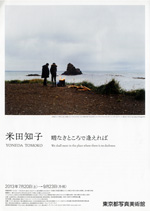 |
 |
|
| Tomoko Yoneda: we shall meet in the place where there is no darkness |
| 20 July - 23 September 2013 |
Tokyo Metropolitan Museum of Photography
(Tokyo) |
 |
| Based in Europe and an expatriate for some two decades, photographer Yoneda is the subject of a major retrospective in her homeland for the first time. In series like "Scene," "Japanese House," "The Island of Sakhalin," and "The Parallel Lives of Others," her camera often scrutinizes sites in East Asia that bear the scars of World War II. Of particular note in this expansive show, however, is "Cumulus," a new series she says was inspired by the earthquake and tsunami of March 2011. |
|
|
|
|
 |
|
|
 |
|